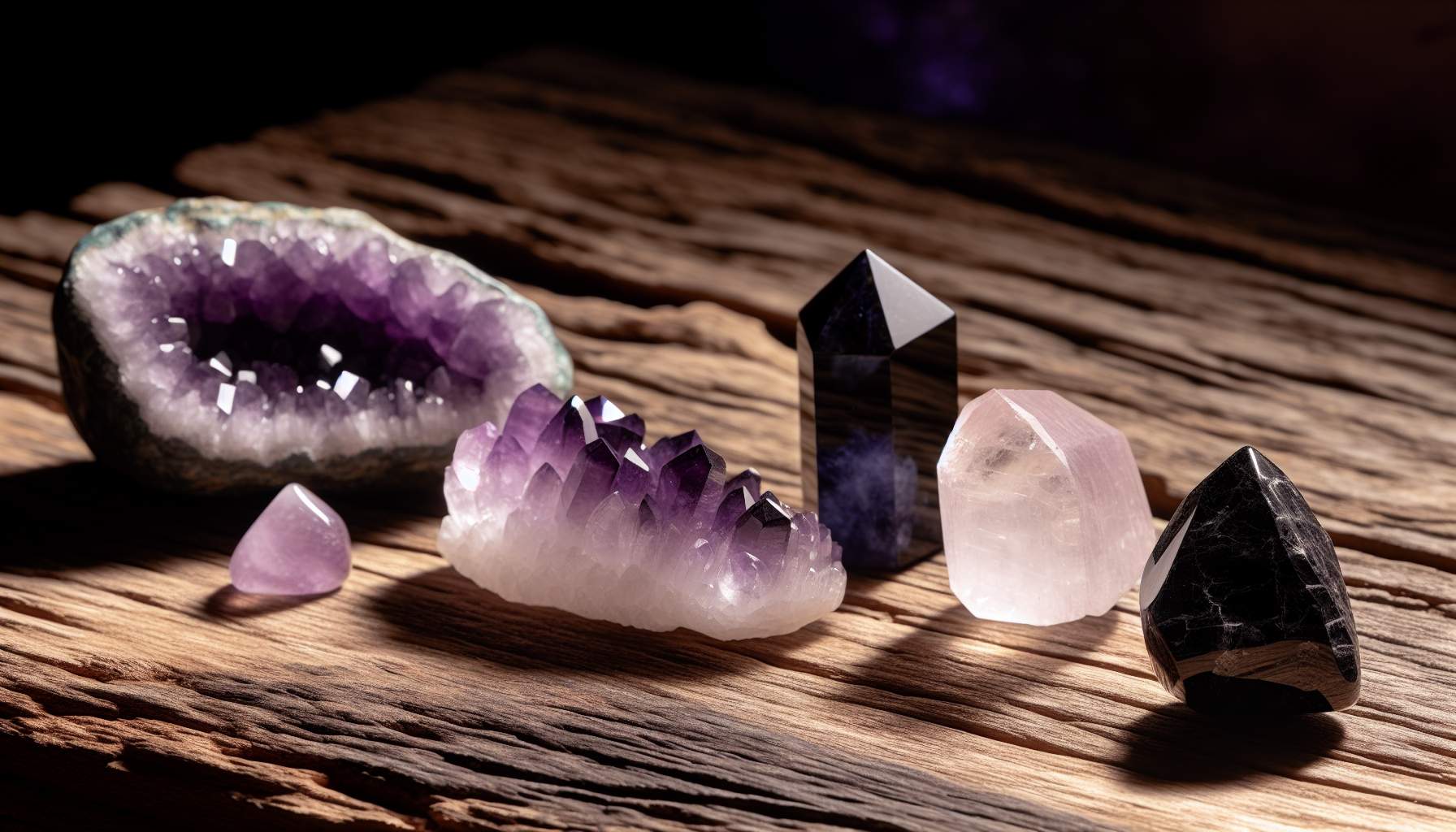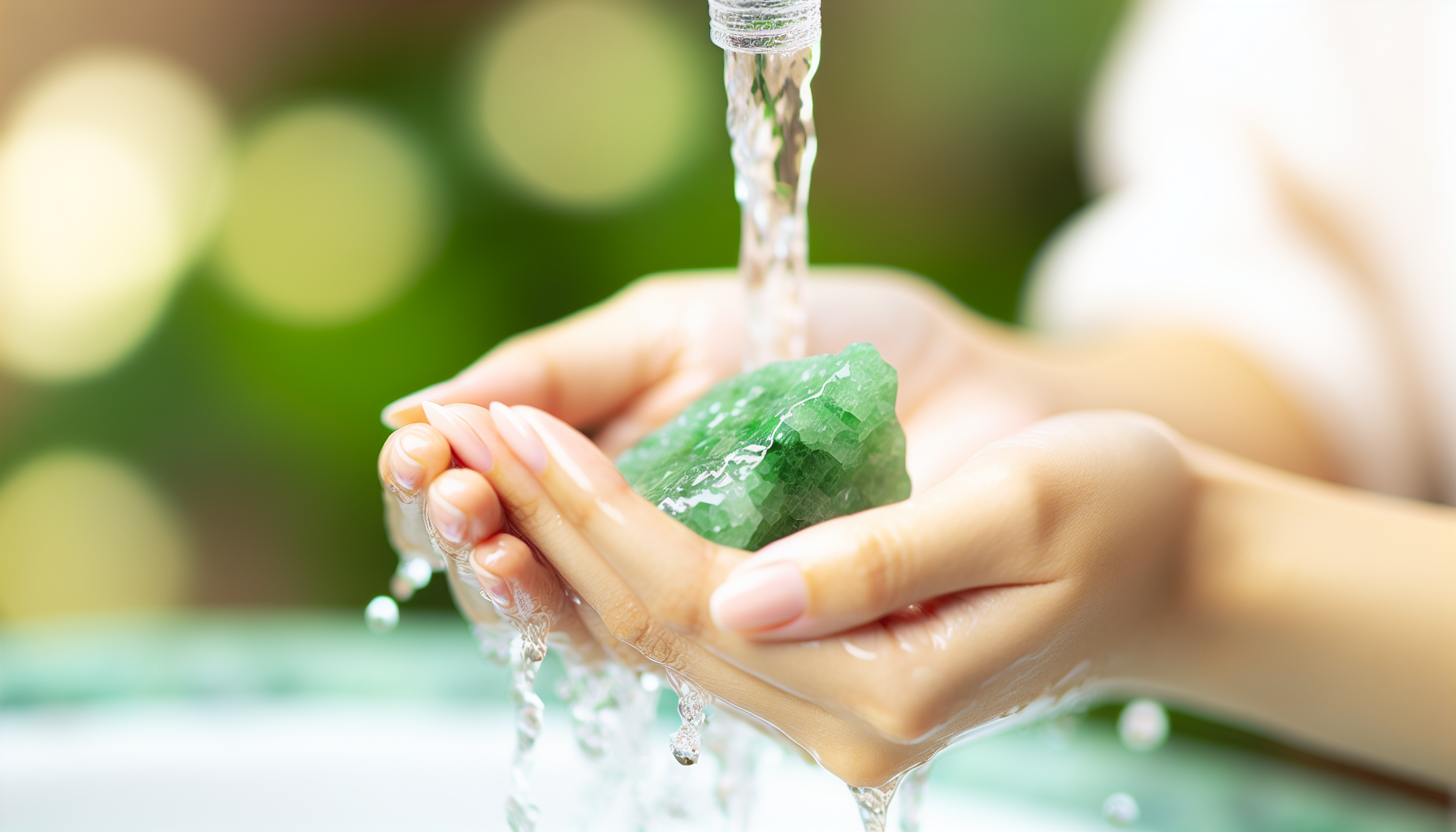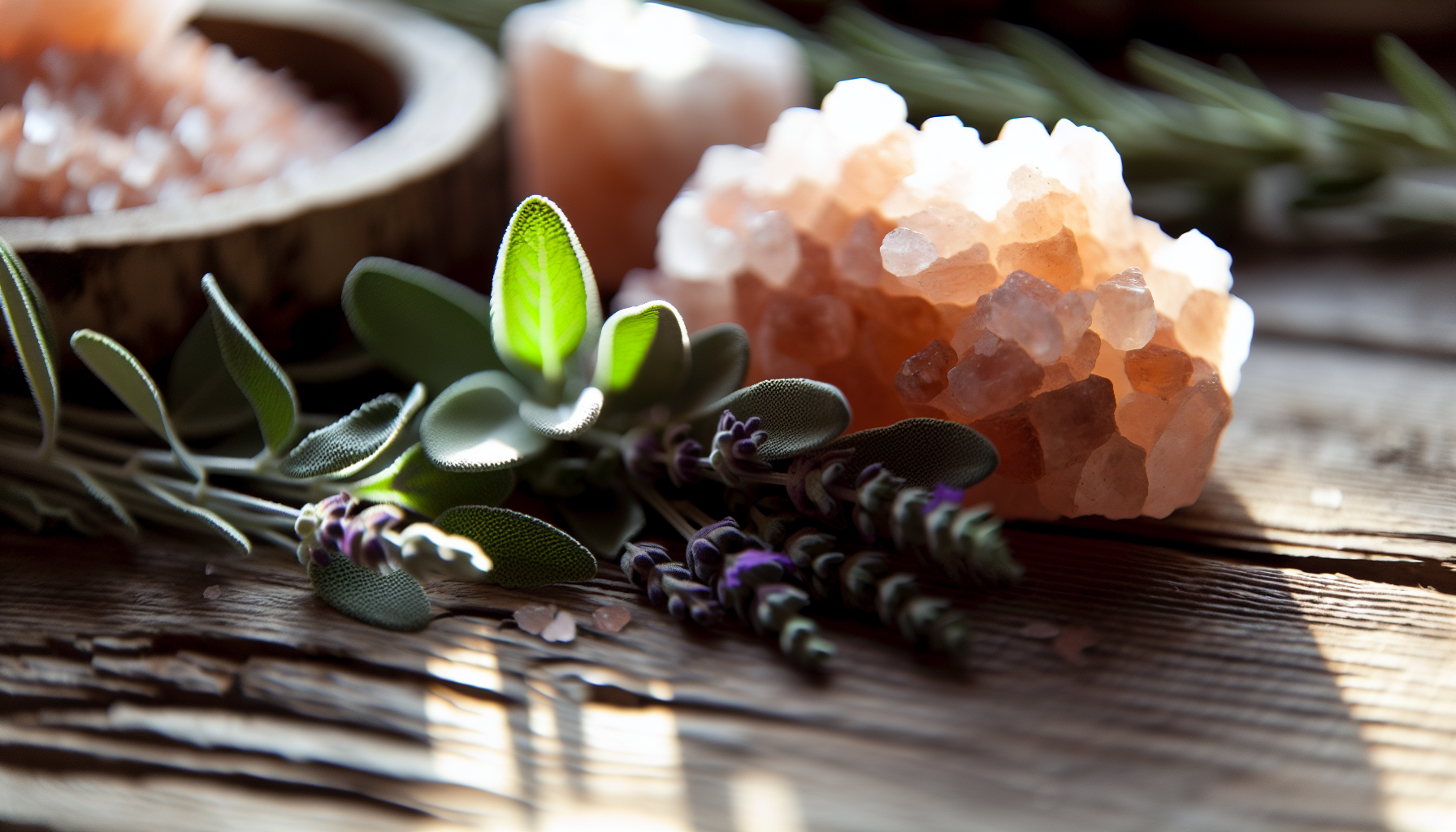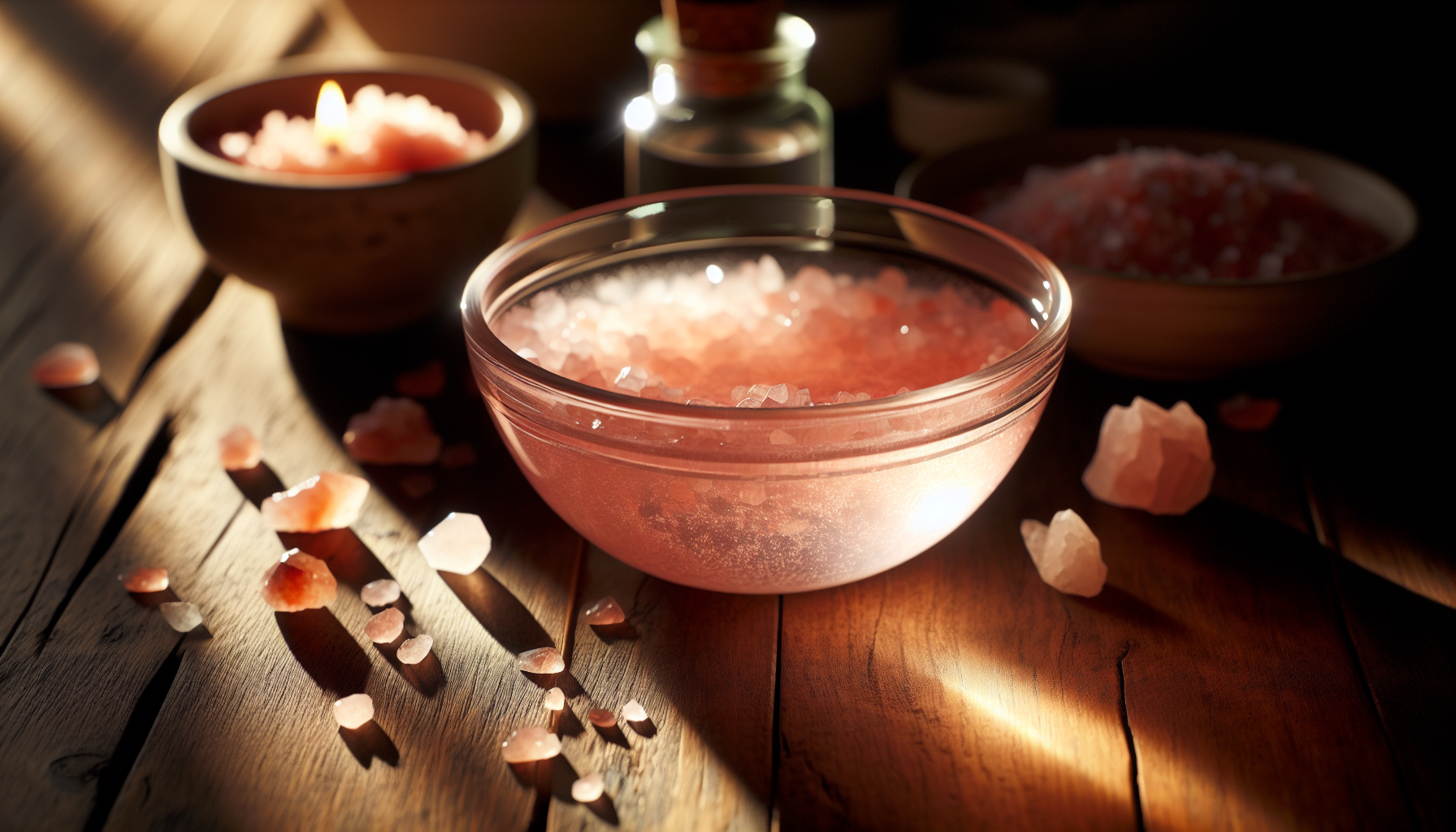Salt is a powerful cleansing agent for certain crystals, but should be used with caution. 10 salt safe crystals include Blue Lace Agate, Amethyst and Clear Quartz. Those unsuitable have Mohs hardness ratings below 7. Regularly cleanse your healing crystals to preserve their therapeutic qualities, eliminate negative energy and ensure they serve their purpose.
Have you ever gazed at the twinkling beauty of a crystal and pondered over its purity? That purity is no accident. It’s achieved through a process known as cleansing, which is vital in maintaining the healing properties of these natural wonders. But here’s the catch; not all crystals can be cleansed in the same way, especially when it comes to using salt. Let’s embark on a journey to understand the nuances of crystal cleansing and the importance of salt safe crystals.
10 Crystals That Can Go In Salt

Just as the earth is blessed with a diverse array of crystals, these crystals possess unique properties, making them either suitable or unsuitable for cleansing in salt. Among the numerous crystals that Mother Earth has gifted us, ten stand out for their salt tolerance. These include:
- Blue Lace Agate
- Amethyst
- Clear Quartz
- Black Tourmaline
- Sodalite
- Green Aventurine
- Fluorite
- Lepidolite
- Celestite
- Turquoise
These crystals not only withstand salt but also derive benefits from it. From grounding and stabilizing energy to augmenting creativity and self-esteem, these crystals absorb negative energy and protect against negative energies, promoting health and emotional stability.
However, before you immerse your precious crystals in a Himalayan salt bath, some precautions are necessary. It’s important to gather information first, particularly regarding the type of salt you’re using. For instance, table salt is a big no-no when it comes to crystal cleansing. Also, avoid heaping too many salt crystals together, as this might cause them to clump, making it a challenge to disentangle them.
7 Crystals That Can’t Go In Salt
While salt provides an effective cleansing solution for many crystals, it’s not a one-size-fits-all solution. Some crystals, like Selenite, Malachite, and Calcite, are not salt-friendly. The reason is simple; salt, including rock salt, can be abrasive and damaging to certain semi-precious gemstones, making them lose their shine and vitality. This is particularly true for crystals with a Mohs hardness rating below 7. Therefore, it’s best to keep such crystals away from salt.
Besides the three mentioned, other crystals that should avoid a salt bath include:
- Red Jasper
- Unakite
- Tahitian Black Pearls
- Aquamarine
While salt can be beneficial for some crystals, it can be a nemesis for others. Hence, it’s necessary to understand your crystals well before selecting the most suitable cleansing method for them.
How to Identify Salt Safe Crystals?

Being aware of which crystals can and can’t go in salt is critical to maintaining your crystals’ longevity and effectiveness. If you’re unsure, it’s always safer to avoid using salt as it can cause the crystal to dissolve. Understanding the types of crystals that are salt safe can be broken down into three main categories: quartz family gems, robust stones suitable for salt baths, and exceptional cases.
Let’s examine these categories more thoroughly.
Quartz Family Gems
The Quartz family is renowned for its diverse range of gems that are salt tolerant. These include clear quartz, smoky quartz, rose quartz, amethyst, citrine, and agate. The Quartz family gems are not just beautiful to look at, but they also possess the capacity to amplify energy and intention and safeguard against negativity.
What makes these gems salt safe is their chemical composition – silicon dioxide (SiO2). The structure of quartz crystals, a three-dimensional network of [SiO4] 4–-tetrahedra interconnected via oxygen atoms, provides them with corrosion and wear resistance, making them highly durable in salt solutions, similar to the properties of pink salt.
Robust Stones for Salt Baths
While Quartz family gems are usually safe for salt, they’re not the only ones. Some robust stones, such as Tiger’s Eye, can also withstand the corrosive properties of salt water. Their hardness, stability, and durability make them suitable for salt baths.
However, keep in mind that salt can react with the trace minerals in crystals and potentially cause damage. It may scratch softer stones and diminish their appearance. Consequently, it’s important to refrain from using salt with stones that are porous, contain metal, or have a high water content.
Exceptional Cases
Just like in any other field, there are always exceptions to the rule in the world of crystals too. In the context of salt cleansing, crystals with essential oils and those with water content fall into this category of exceptions. Essential oils may be toxic and thus not suitable for use with salt.
On the other hand, while some crystals like rose quartz, aquamarine, larimar, and blue lace agate are particularly suitable for cleansing with water, their reaction to salt varies. Salt crystallization may be more damaging to stones with small pores than to those with larger ones. Hence, it’s always advised to consider the specific properties of the crystal before using salt cleansing methods involving water.
Understanding Salt’s Role in Crystal Cleansing

Now that we’ve understood which crystals are salt-friendly and which ones are not, it’s time to delve into the role of salt in crystal cleansing. Salt, in the context of crystal cleansing, serves a dual purpose. It helps eliminate impurities and contaminants from the crystals and draw out negative energy.
However, it’s important to remember that while salt can be a powerful cleansing agent, it’s not suitable for all crystals. Salt can be detrimental to porous crystals, and certain crystals can disintegrate in saltwater. Despite its cleansing properties, it’s important to use salt carefully during crystal cleansing.
The Salt Cleansing Process Explained

Understanding the process of salt cleansing is key to effectively cleanse your crystals. The salt cleansing process is a multi-step one, involving the preparation of the salt solution, the duration of the cleansing, and the aftercare.
Let’s analyze this process in more detail.
Preparing Your Salt Solution
The first step in the salt cleansing process is preparing your salt solution. The best types of salt to use for this purpose are sea salt or pink Himalayan salt. You’ll need approximately one teaspoon of sea salt mixed into lukewarm water to create the cleansing solution.
To make sure you have a saturated solution, follow these steps:
- Add salt slowly and stir until it dissolves.
- Keep adding salt while maintaining the desired temperature until it no longer dissolves.
- This is when you know your salt solution is ready for the cleansing process.
Duration and Aftercare
Once your salt solution is ready, the next step is immersing your crystals in it. The recommended duration for this is a full 24 hours or longer if one resides near the sea. This duration helps the salt effectively draw out the negative energy from the crystals.
After your crystals have had their salt bath, it’s time for the aftercare. Rinse your crystals meticulously with cool water before storing them. This helps remove any residual salt from the crystals and leaves them in a clean state.
Alternative Methods for Non-Salt Safe Crystals

If certain crystals can’t tolerate salt, don’t fret, there are other cleansing methods available! These include sound and vibration techniques, lunar and solar energy, and smudging rituals. Each of these methods offers unique ways to cleanse your crystals without risking damage from salt.
Sound and Vibration Techniques
Sound and vibration techniques provide an interesting way to cleanse your crystals. These methods involve using:
- Mantras
- Prayers
- Affirmations
- Meditation
- Crystal wands
To cleanse your crystals, it’s important to remember that not all crystals can be cleansed using the same method.
The principle behind these methods is that the vibrations generated by sound can shake out the negative energy that the crystal has absorbed, providing an effective means of cleansing and recharging crystals. Whether you use singing bowls or play music at a high volume, the principle remains the same – use sound to cleanse your crystals!
Lunar and Solar Energy
Another effective method of cleansing crystals is harnessing the power of lunar and solar energy. This method involves placing your crystals under the moonlight or sunlight to cleanse their energy.
While placing your crystals under the full moon can help recycle the negative energy stored within them, exposing them to sunlight can cleanse their energy and increase their potency for healing. However, don’t forget to study the unique characteristics of each crystal to determine the most effective cleansing method.
Smudging Rituals
Smudging is a traditional Native American custom that involves burning dried herbs such as sage to dispel negative energy. Smudging can be used to cleanse crystals that are not salt safe.
When engaging in a smudging ritual, it’s important to observe certain measures. Here are some guidelines to follow:
- Ensure proper ventilation.
- Use a fireproof vessel.
- Keep a bowl of water nearby.
- Exercise caution with fire safety.
- Respect individual limits.
- Be cautious of smoke allergies.
What are the Benefits of Cleansing Your Crystals Regularly?
You might be wondering, why go through all this trouble? Well, regularly cleansing your crystals can have several benefits. It helps to preserve their therapeutic qualities and eliminate negative energy. This regular maintenance ensures that your crystals are always at their best when it comes to healing properties.
It’s recommended to cleanse your crystals at least once a month or whenever their energy seems to be diminishing or becoming oppressive. So whether you’re using Clear Quartz for clarity of thought or Chalcedony as an energy crystal, regular cleansing ensures that your crystals continue to serve you well.
How to Care for Your Healing Crystals?
Besides regular cleansing, proper care of your healing crystals can ensure their longevity and effectiveness. There are various methods for cleansing healing crystals such as using selenite, smoke from sage, herbs, or incense, or placing them in a bowl of distilled water.
When it comes to storing your healing crystals, you have a few options:
- Store them in storage boxes or chests lined with fabric
- Keep them out of direct sunlight
- Place them in organza bags or velvet pouches for tumbled crystals
- Display them near a window or on a bookcase
- Store them inside a drawer using small gift boxes
Remember, regular charging or cleansing of your healing crystals is necessary to maintain their optimal performance.
Summary
In conclusion, the world of crystals is as complex as it is beautiful. Whether you’re using Himalayan salt or sound and vibration techniques, understanding the right cleansing method for your crystal is key to maintaining its healing properties. And while the process might seem daunting at first, remember that the journey to maintaining purity is just as rewarding as the destination itself. So, go ahead, embrace the power of your crystals, and let them guide you towards a healing journey.
Frequently Asked Questions About Salt Safe Crystals
What crystals can be charged with salt?
Quartz, amethyst, and turquoise are some crystals that can be charged with saltwater to help remove negative energy and restore healing properties.
What crystals arent safe to salt?
It is not recommended to soak 21 common crystals in salt water, as this could damage them. It is best to avoid doing so entirely.
How often should I cleanse my crystals?
It is recommended to cleanse your crystals at least once a month or whenever their energy seems to be waning.
Can sound and vibration techniques be used to cleanse all crystals?
Yes, sound and vibration techniques can be used to cleanse all crystals.
What precautions should be taken during a smudging ritual?
When engaging in a smudging ritual, proper ventilation, fireproof vessels, water and caution with fire safety should be ensured, individual limits respected and smoke allergies taken into consideration.